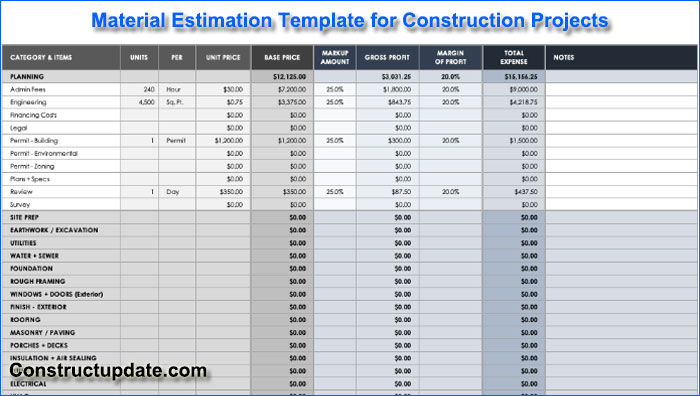Material Estimation Template for Construction Projects: Key Design Considerations & Benefits
For construction projects to be successful, accurate material estimation is essential. It reduces wasteful material use, manages expenses, and avoids project delays. This procedure can be streamlined with a well-designed estimate template, guaranteeing accuracy and efficiency.
Key Considerations for Construction Estimate Template Design:
1. Project Scope and Complexity:
The template ought to be flexible enough to accommodate different project sizes and types (residential, commercial, and industrial). It should support particular needs, such as customized systems, coatings, and structural materials.
2. Material Categories:
Organize the template into clear categories like:
Structural: Concrete, steel, timber
Finishes: Flooring, wall coverings, ceilings
MEP: Mechanical, Electrical, Plumbing
Landscaping: Soil, plants, hardscaping

3. Unit of Measure:
Establish uniform measurements for every material, such as linear feet for lumber, square feet for flooring, and cubic yards for concrete. This avoids mistakes and guarantees precise amount computations.
4. Takeoff Methods:
Incorporate different takeoff methods:
Dimensional Takeoff: Based on plans and drawings, measure lengths, widths, and heights.
Quantity Takeoff: Extract quantities directly from plans and specifications.
Unit Cost Method: Assign unit costs to materials based on historical data or market prices.
5. Waste Factors:
Take into consideration material waste that occurs during handling, installation, and transportation. Add the waste factors that are unique to each kind of material.
6. Labor Costs:
Include fields for labor prices and hours for each material installation, if applicable.
7. Pricing and Costing:
Unit Prices: Add columns for subtotals, extended expenses, and unit prices.
Markup: Make room for markups to cover profit, overhead, and unforeseen expenses.
8. Data Entry and Calculations:
Formulas: To automate computations, use spreadsheet formulas (e.g., area, volume, total cost).
Lookups: Include lookup tables for waste factors and material costs.
9. Reporting and Analysis:
Create summary reports that include the total project budget and material costs.
Graphs and Charts: Compare various possibilities and visualize the cost of the materials.
10. Software Integration:
Take into account integrating the template with platforms for building information modeling (BIM), accounting software, or project management software.
Benefits of Using a Well-Designed Estimating Template for Construction:
- A higher level of accuracy lowers the possibility of mistakes and omissions in material computations.
- Increased Efficiency: Saves time and money by streamlining the estimating process.
- Improved Cost Control: Facilitates precise cost tracking and planning during the project.
- Improved Communication: Makes it easier for suppliers, contractors, and estimators to communicate clearly.
- Better project management lays the groundwork for more effective project planning and implementation.
Construction firms can greatly increase the profitability and competitiveness of their projects by meticulously creating and putting into practice a thorough material estimating template.




